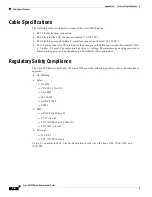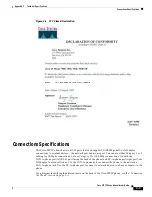
B-56
Cisco SIP IP Phone Administrator Guide
Appendix B SIP Call Flows
Call Flow Scenarios for Failed Calls
Call from a Cisco SIP IP Phone to a Cisco SIP IP Phone via a Backup Proxy
Figure B-21
illustrates a successful call from a Cisco SIP IP phone to a Cisco SIP IP phone via a backup
proxy.
5.
INVITE—Cisco SIP IP phone to
primary proxy (fifth try)
Cisco SIP IP phone retries a fifth time to connect to the proxy by sending out the
INVITE message.
6.
INVITE—Cisco SIP IP phone to
primary proxy (sixth try)
Cisco SIP IP phone retries a sixth time to connect to the proxy by sending out the
INVITE message.
7.
INVITE—Cisco SIP IP phone to
primary proxy (seventh try)
Cisco SIP IP phone retries a seventh time to connect to the proxy. If the
connection is not successful after this trial, “Network Delay, Trying Backup”
message displays on the Phone.
8.
INVITE—Cisco SIP IP phone to
gateway (backup proxy)
Cisco SIP IP phone tries to connect to the gateway (backup proxy) by sending out
the INVITE message.
9.
Setup—Gateway to PBX
Call Setup is initiated between gateway to PBX. The Call Setup includes the
standard transactions that take place as User A attempts to call User B.
10.
Call Proceeding—PBX to
gateway
PBX sends a Call Proceeding message to gateway to acknowledge the Call Setup
request.
11.
100 Trying—Gateway to
Cisco SIP IP phone (User A)
Gateway sends a SIP 100 Trying response to User A. The 100 Trying response
indicates that the INVITE request has been received by the gateway.
12.
Alerting—PBX to gateway
PBX sends an Alert message to gateway. The Alert message indicates that PBX
has received a 100 Trying Ringing response from the gateway.
13.
180 Ringing—Gateway to
Cisco SIP IP phone (User A)
The gateway sends a SIP 180 Ringing response to User A. The 180 Ringing
response indicates that the gateway is being alerted.
14.
Connect—PBX to gateway
PBX sends a Connect message to gateway. The Connect message notifies the
gateway that the connection has been made.
15.
200 OK—Gateway to
Cisco SIP IP phone (User A)
Gateway sends a SIP 200 OK response to the User A. The 200 OK response
notifies User A that the connection has been made.
16.
ACK—Cisco SIP IP phone
(User A) to gateway
User A sends a SIP ACK to the gateway. The ACK confirms that User A has
received the 200 OK response. The call session is now active.
17.
Connect ACK—Gateway to
PBX
Gateway acknowledges PBX’s Connect message.
18.
BYE—Cisco SIP IP phone
(User A) to gateway
User A terminates the call session and sends a SIP BYE request to gateway. The
BYE request indicates that User A wants to release the call.
19.
Disconnect—Gateway to PBX
Gateway sends a Disconnect message to PBX.
20.
Release—PBX to gateway
PBX sends a Release message to gateway.
21.
200 OK—Gateway to
Cisco SIP IP phone (User A)
Gateway sends a SIP 200 OK response to User A. The 200 OK response notifies
User A that the gateway has received the BYE request.
22.
Release Complete—Gateway to
PBX
Gateway sends a Release Complete message to PBX and the call session is
terminated.
Step
Action
Description
















































